North Asia's airlines add capacity in 2014 as underdogs play catch up and short haul focus increases
All of North Asia's main 13 airlines except Korean Air will operate more flights in the first quarter of 2014 than in the year prior. But this has different impacts and not all airlines will grow seat and ASK capacity. On average 1Q2014 seats will be up 3.7% and ASKs 3.4% complementing 4.5% growth in frequencies. For Cathay Pacific and Japan Airlines, more frequencies come at the expense of ASKs as aircraft are down-gauged or see lower configurations. For others, frequency growth faster than seat/ASK growth will allow them to tap new short-haul markets.
Hong Kong Airlines, China Southern, EVA Air and TransAsia are due to be the region's largest-growth carriers. Carriers in Greater China are introducing seat and ASK growth above frequency growth due to limited slots and the nature of trunk routes. China Airlines and EVA Air have a similar growth profile, but in other markets the two big carriers (ANA and JAL in Japan, Asiana and Korean Air in Korea) differ.
The uniting theme is carriers looking to close the gap while incumbents seek sustainability. 1Q2014 is a relatively tame start to the year, which will see expansion from ANA at Haneda, Asiana take A380s and launch more long-haul flying, Skymark become Japan's third long-haul airline and Cathay put in 6.3% ASK growth after two quiet years.
North Asia's main airlines to grow about 4% in 1Q2014
North Asia's 13 largest carriers (excluding primarily domestic operators in China) will grow about 4% in the first quarter of 2014 compared to the first quarter of 2013, according to OAG data. On average seats will be up 3.7%, ASKs up 3.4% and frequencies up 4.5%.
Seat, ASK and frequency growth amongst select North Asian airlines: 1Q2014 versus 1Q2013
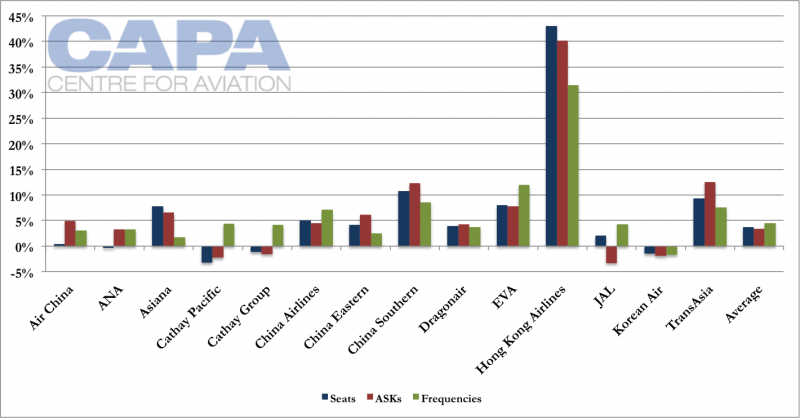
At five carriers - China Airlines, China Southern, EVA Air, Hong Kong Airlines and TransAsia - seats, ASKs and frequencies will be up above average. Asiana will have above average seat and ASK growth but below average frequency growth. Air China and ANA will have about average ASK and frequency growth but below average seat growth.
China Eastern will have slightly above average seat and ASK growth but below average frequency growth. The Cathay Pacific Group (labelled in the above chart as "Cathay Group") will see growth in frequencies but declines in seats and ASKs; this is the result of Cathay mainline's ("Cathay Pacific") more pronounced frequency growth with seat and ASK decreases averaged out by Dragonair's across-the-board growth in seats, ASKs and frequencies. JAL sees growth in seats and frequencies but declines in ASKs. Korean Air across the board has negative growth.
Many of the changes are not due to capacity being added this quarter but rather to the realisation of growth implemented in past quarters.
Largest growers: Hong Kong Airlines, China Southern, EVA and TransAsia
The fastest-growing carrier by far is Hong Kong Airlines, which continues exceptionally high double-digit growth to catch up after a late start and to use slots at congested Hong Kong Airport before they are largely fully utilised. Mainland China accounts for about 60% of its seat capacity. Hong Kong Airlines has narrowed the gap with rival Dragonair.
Hong Kong Airlines has scheduled service to 17 mainland Chinese destinations compared to Dragonair's 21, according to OAG. Hong Kong Airlines focuses on the local Hong Kong-mainland China market and transfer traffic from mainland China to Southeast Asia, which comprises about a quarter of its capacity. There are also traffic flows around Japan and Taiwan, as well as to the Maldives. Hong Kong Airlines does not release traffic results; figures are bundled into the much larger HNA Group.
Hong Kong Airlines seat capacity by country/territory: 6-Jan-2014 to 12-Jan-2014

China Southern (Asia's largest) is the only other carrier introducing double-digit seat and ASK growth. The domestic market still comprises about 86% of seat capacity. The growth continues China Southern's high pace of past years.
China Southern Airlines monthly available seat kilometres (Domestic): 2011-2013*
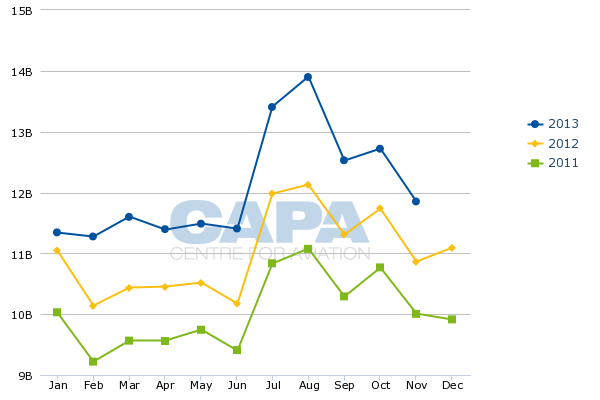
China Southern Airlines monthly available seat kilometres (International): 2011-2013*

However, growth is expected to slow in order to correct the imbalance between demand and supply that has been most visible via declining domestic load factors. Most of 2013's monthly load factors were below 2012 levels, which in turn were below 2011 levels.
China Southern Airlines monthly passenger load factor (Domestic)*: 2011-2013
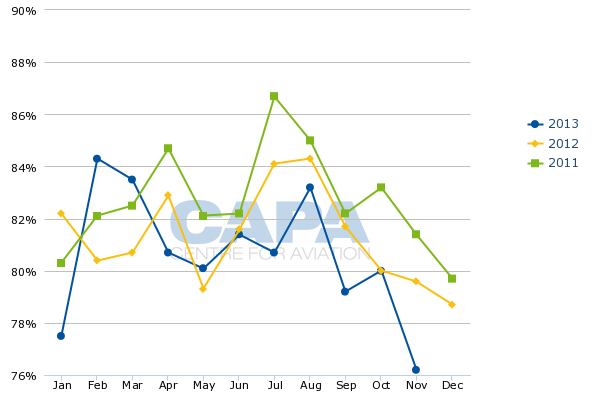
Taiwan's under-appreciated EVA Air continues to take a larger role in North Asia. Noticeable growth is occurring in its two largest markets of Japan and China.
EVA's weekly scheduled seats to Japan are increasing about 25% from 16,000 in 1Q2013 to 20,000 in 1Q2014, according to OAG. Mainland China scheduled capacity will grow from 15,000 weekly seats to 18,000. Much of the growth is with smaller aircraft, explaining EVA Air's higher frequency growth than seat or ASK growth.
Taiwan to Japan (seats per week, one way): 19-Sep-2011 to 6-Jul-2014

Taiwan to China (seats per week, one way): 19-Sep-2011 to 6-Jul-2014
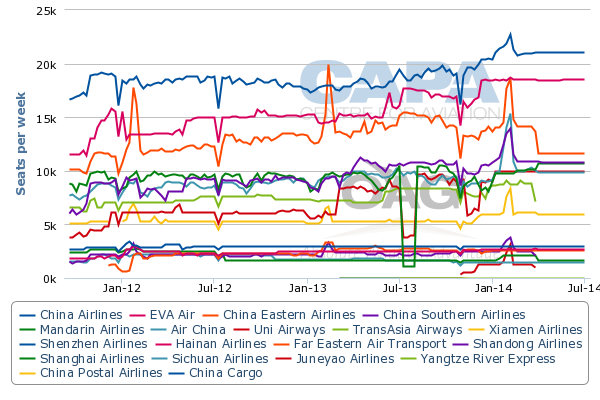
Also in Taiwan, TransAsia continues its large growth, albeit from a much lower base. As with EVA Air the driving components are short-haul flights to mainland China and Japan.
Unlike EVA Air, TransAsia's ASKs are growing faster than frequencies due to more medium-haul flying to Thailand and Japan. TransAsia remains heavily focused on Northeast Asia, which accounts for 91% of seat capacity.
TransAsia international seat capacity by country: 6-Jan-2014 to 12-Jan-2014
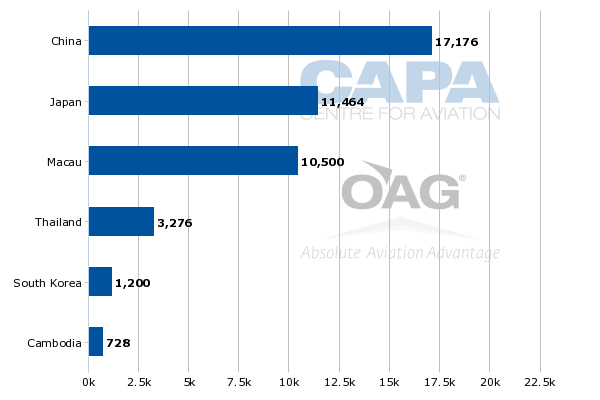
Shift to smaller but more efficient aircraft, lower-density configurations brings Cathay and JAL's capacity down
Cathay Pacific, JAL and Korean Air will have lower capacity in 1Q2014 than 1Q2013. Korean Air's decline is relatively even across the board of seats, ASKs and frequencies (down 1-2%) whereas Cathay and JAL are recording more prominent seat and/or ASK declines while growing frequencies. This is largely the result of the two using smaller but more efficient aircraft as well as more premium but less dense cabin configurations.
Cathay mainline (excluding regional-focused Dragonair) will shrink seat capacity by about 3% and ASKs by 2% while growing frequencies 4%, according to OAG. This is largely explained by Cathay replacing long-haul 747-400 services with 777-300ERs. While the 777-300ERs have a smaller capacity, bringing traffic/capacity figures down, their improved economics is a strong gain for profits - or reversing losses incurred with 747-400s. Frequency growth (such as a fifth daily flight to London Heathrow, and additional frequencies to North America) offsets the loss of seats from replacing 747-400s with 777-300ERs.
On the configuration front, 1Q2014 sees a realisation of more aircraft flying with the carrier's new business class and premium economy product, which were put in at the expense of seat density. Premium economy seats have helped improve economy yields while the benefit from a better business class seat is more difficult to quantify.
Despite 1Q2014 seeing 16% more Cathay frequencies to North America, capacity is recording low single digit gains.
Hong Kong to North America (seats per week, one way): 19-Sep-2011 to 6-Jul-2014
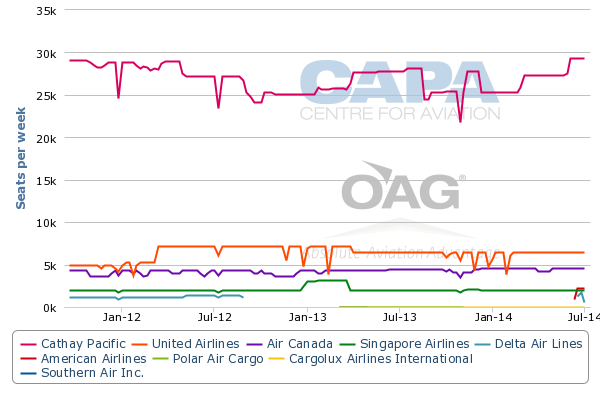
JAL's ASK reduction is a result of some long-haul aircraft changes, such as the lower-density 787-8 replacing the 777-200ER operating to San Francisco. But the larger impact to JAL is its long-haul 777-300ER re-configuration that saw capacity per aircraft decline from 272 or 246 to 232. The roll out of the new configuration started in 1Q2013, so 1Q2014 is seeing the full realisation of previous changes.
Meanwhile JAL's seat numbers are up due to increased short-haul flying. This boosts the seat capacity figure but ASKs record a decline from reduced long-haul flying, although 1Q2014 sees the full quarter impact of JAL's Narita-Helsinki route and the start (resumption) of a second daily Narita-New York JFK service. Additional (but more limited to ANA) long-haul growth will occur in 2014 as JAL uses newly awarded Haneda slots.
The imbalance between frequency growth and seat/ASK growth will make cost comparisons complex during this transition period. For example, reduced seats and ASKs at Cathay can equate to lower fuel costs due to the use of more efficient aircraft but can also equate to higher staff costs since there are more flights. More short-haul flying at JAL may impact its overall cost base since short-haul flying is not as efficient as long-haul flights.
Greater China airlines see faster seat/ASK growth than frequency growth
Three carriers in greater China - China Eastern, China Southern and Hong Kong Airlines - are recording seat/ASK growth at rates higher than frequency growth. This is reflective of up-gauging of aircraft types to accommodate growth in absence of new slot availability, as well as the better economics of operating larger-capacity aircraft on trunk routes, especially the A330, which has become more popular in China.
See related report: Lower-weight A330 targeted at China, with its high dependence on widebody aircraft for trunk routes
Air China is introducing higher ASK growth than frequency growth, but almost flat seat capacity growth. This is partially a result of it being impacted, like Cathay and JAL, by replacing high-density aircraft with lower-density ones (in its case, replacing 747-400s with 777-300ERs). ASKs on the whole record a gain at Air China from more long-haul flying. The up-gauging trend was evident in Air China's 1H2013 fleet changes, which involved the replacement of two 767-300s with three larger A330-300s and the replacement of six 737-300s with seven larger 737-800s/A320s/A321s.
Elsewhere in greater China, China Airlines and EVA Air are not following this trend (they are seeing higher frequency growth than seat/ASK growth). They have already deployed their largest aircraft - including 747-400s - on the short one or two hour hops between Taipei and China's main cities. Growth between and Taiwan and mainland China is mainly occurring on thinner routes better served by narrowbodies (and which even then can be unprofitable).
Dragonair, which does most of the Cathay Pacific Group's flying to mainland China, is introducing relatively similar growth between seats, ASKs and frequencies. Cabin configurations are once again an impact as Dragonair's two-class A330s decrease from 44 or 42 business class seats to 30; economy remains more or less steady. Up-gauging is apparent as Dragonair will take two A321s in 2014 (one each in Feb and Oct). This will bring its A321 fleet to eight. The addition of A321s is notable given Dragonair's growth in recent years has mainly been with A320s and A330s. The A321 in Jan-2014 is the least represented type in Dragonair's fleet, at six aircraft. Dragonair has 15 A320s and 19 A330s.
ANA & JAL, and Asiana & Korean Air each adopt different strategies
China Airlines and EVA Air largely mirror each other in growth, although EVA Air is growing more - perhaps to catch up to its larger rival, nearly 50% bigger.
But in Japan and Korea, each country's two main carriers are taking different growth strategies. Beleaguered Asiana will grow seats about 8% while Korean Air will see seats decline about 1-2%. This continues the theme of Asiana growing faster than Korean Air - or as is now the case, Asiana growing while Korean Air shrinks. Asiana is keen to reduce its reliance on short-haul flying.
As in Taiwan, the smaller carrier (Asiana) may be looking to catch up to the larger carrier (Korean Air). Market conditions however may not be right, with impacts felt in the short term, as Asiana and Korean Air have experienced with weak financial results. But these airlines are taking a long-term view. They are fortunate in largely not having to answer to investors looking for short-term improvement (Asiana is part of the Kumho Asiana Group while EVA Air is part of the Evergreen Group).
See related reports:
- Korean aviation in flux. Asiana's new CEO comes from LCC Air Busan; AirAsia Korea files application
- Korean airline yields deteriorating in key markets of China and Japan; capacity discipline needed
In Japan, ANA is growing ASKs and frequencies as it grows more long-haul but keeps domestic capacity (which accounts for about 85% of capacity) relatively flat. North America was a large recipient of high ASK growth in 2013 for ANA. JAL is growing seats and frequencies with declines in ASKs, a result of domestic seat growth (which has a comparatively smaller impact on ASKs) and lower-density international flights (larger impact on ASKs). JAL in Jan-2014 is about 55% the size of ANA in the domestic market, so there is room for it to grow - but not too much; ANA is arguably over-exposed, partially evidenced by its declining load factors on key city pairs that overlap with LCCs.
Internationally, a much smaller post-bankruptcy JAL has in Jan-2014 about 6% more seat capacity and 2% more ASKs than ANA. ANA wants to overtake JAL.
See related report: All Nippon Airways and Japan Airlines respond differently to country's LCCs; is JAL faring better?
The Big 3 Chinese carriers are broadly in line with each other, except Air China, which as noted earlier is making gauge and frequency changes to its long-haul network.
This is part of a subtle shift from domestic to international flying, which is potentially a better use of limited slots at its hub airport of Beijing Capital (trip revenue per Beijing movement may be higher but yields and profits lower). Frequencies are growing elsewhere in the Air China network with domestic flights between secondary cities using smaller aircraft.
See related report: Air China turns attention to international markets, but its profits are regional and domestic
Modest start to 2014; more expansive growth awaits as airlines look to narrow gaps and the LCC invasion influences policy
The modest capacity growth planned in 1Q2014 will undoubtedly pick up through the year as gauge/configuration changes currently dragging down growth no longer impact year-on-year comparisons. They need net growth. The Cathay Pacific Group is the lone voice in making an ASK growth prediction for 2014: 6.3%, a high figure considering weaker performance in 2012 and 2013. That figure will also encapsulate ongoing 747-400 replacement with 777-300ERs, meaning frequency growth will continue to be high.
EVA Air later in 2014 will increase frequencies to North America, Asiana will take delivery of its first A380s that allow needed long-haul growth, ANA launches new international flights made possible by new Tokyo Haneda slots and Skymark becomes Japan's third long-haul carrier, to name but a few potential highlights. The year is just starting, and undoubtedly there will be surprises - some well executed, some in need of refinement.
With the exception of Korean Air, all of North Asia's 13 airlines in this evaluation are due to operate more flights in 1Q2014 than a year earlier.
The strategy and impact varies: for Cathay, more flights means better operating economics at the expense of seats/ASKs; for China Airlines and EVA Air, higher frequency growth than seat/ASK growth is the result of reaching new short-haul markets; for China's Big 3 and Hong Kong Airlines, seats and ASKs grow faster than frequencies (out of necessity from limited slots); for TransAsia ASKs grow the largest as it diversifies away from its North Asian staple while Asiana is seeking more long-haul flying to reduce its short-haul exposure.
Seat and ASK figures may vary, but each airline hopes to become more sustainable in the long term from its decision to have more flights.
If there is an over-riding theme, it is to narrow gaps, as the underdogs strive to challenge their larger local competition: Asiana, EVA Air and Hong Kong Airlines want to catch up to their larger rivals, TransAsia wants to break away from its North Asia focus, ANA will likely surpass JAL in international capacity, and China's carriers are looking for more international opportunities but also the chance to refine their own operation and become more efficient with lower domestic growth. The challenge is for carriers to move themselves up to narrow the gap while incumbents in turn push themselves further up to limit inroads from those below.
This is all the while maintaining the status quo of Asia being one of the aviation world's few relatively bright spots in terms of growth and profitability. The focus on organic growth will likely once again in 2014 take centre stage rather than relying on more tactical strategic developments from integrated alliances and partnerships. Those could make the region even more sustainable.
Meanwhile though, greatly increased attention will be focussed on the continuing invasion of North Asia by LCCs from Southeast Asia, both from their home bases and through newly established local joint ventures in North Asia. And with China introducing new rules to encourage its own home grown LCCs, the impact of this new wave will exceed even the actual levels of capacity these carriers add. The wave is growing fast and North Asia's full service airlines will necessarily look to pre-empt erosion of their market shares - either by growing their own capacity or expanding the roles of their own dual branded LCCs